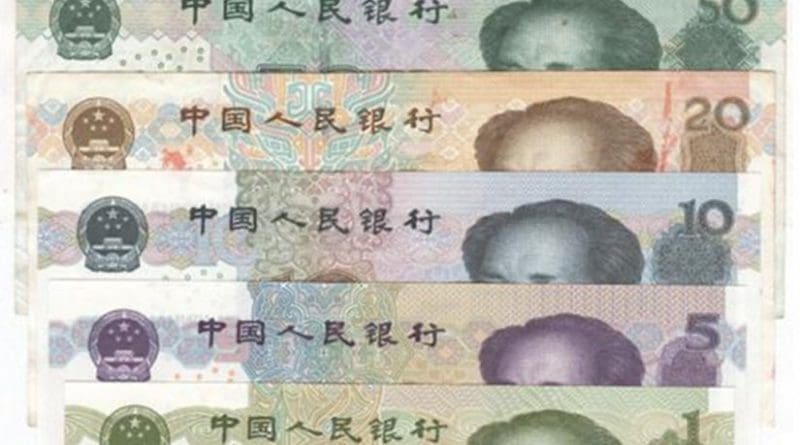China’s Currency Devaluation And India – Analysis
By Observer Research Foundation
By Sriparna Pathak Raimedhi*
China’s devaluation of the Yuan on August 11 has sent panic waves across global financial markets and brought back memories of the Asian financial crisis of 1998 when similar situations prevailed. The biggest fear was this adding to the uncertainty in global financial markets. Additionally, China’s manufacturing data released in August further dampened the sentiments, triggering a fear of certain collapse across global markets. Data released in September showed that factory output in China grew by 6.1 per cent from the year before. This is well below the forecasts of 6.4 per cent. Growth in fixed asset investment slowed to 10.9 per cent for the year to date. This is a 15-year low. Other indications of the slow down include falling car sales and lower imports and inflation. Growth rates were revised recently for 2014- from 7.4 per cent to 7.3 per cent. This is the weakest in nearly 25 years. Given the prevailing conditions in the economy which are seen as signs of a slowdown, currency devaluation is being analysed as a desperate effort by the Chinese government to shore up its declining stock market and managing the slowing economy. A cheaper Yuan definitely means bolstering exports, as it makes exports cheaper and thus more competitive.
The reason given officially for the devaluation is that the People’s Bank of China wants a more market driven exchange rate, and the intersection of demand and supply have now made the Yuan cheaper than what it was before. Demands for the revaluation of the Yuan had been prevalent for quite some time. However, now that the Yuan has depreciated global concerns over currency wars are high. Republican senator and former U.S. trade representative Rob Portman has even accused China of attempting to gain an unfair trade advantage over the U.S. through “currency manipulation”. The devaluation is definitely a symbol of the inherent weaknesses in the Chinese economy. However, if the attempt through devaluation is to increase exports, then what needs to be factored in is that unlike the scenario in the past there are not enough consumers now to buy Chinese goods as global consumers have been affected negatively themselves.
For India, the devaluation means bad news as well as good news. The negative is that Indian exports will come under further strain as China and India compete for several export items such as gems and jewellery, textiles etc. Additionally, a slowdown in China which is one of the top five countries itself for Indian exports is not good news. Fears also exist that the sharp depreciation will aid in more dumping of Chinese goods into the Indian market, hurting domestic manufacturers, which is definitely not something that would help the ‘Make in India’ campaign in any way. India already has a trade deficit of US$ 48 billion with China, and this has increased about 34 per cent from what it was in 2014-15.
The sharp fall in the Indian rupee has already rattled stock markets and if it continues to fall, imports will becoming further more expensive, adding to inflation. The positive is that the slowdown in China has hit global commodity markets as well due to a decline in Chinese demand. Oil and gold prices have fallen, and India which is am importer of oil and gold can seek some relief through lower oil and gold prices which will help the current account deficit. Lower oil prices additionally mean lower inflation rates.
In case there is further depreciation of the Yuan, greater scrambles to seize the lion’s share of global consumer demand will definitely occur. Policy makers in India need to realise that India currently needs to encourage more foreign direct investment into the country. This would require increasing attractions for foreign business ventures to set shop in India. This would definitely add to India’s capabilities for manufacturing and aid exports in case Chinese exports become more competitive, or the Chinese economy spirals downwards into a massive slowdown. Taxation policies also require a rethink in a way that more investors are lured into making investments and not the other way round. The currency devaluation actually is a delicate situation and only time can tell as to how a “restructured” Chinese economy affects the global market. In the meanwhile, India needs to prepare itself to capitalise on the opportunities that emerge and be prepared for the causalities as well.
*The author is an Associate Fellow at Observer Research Foundation, Kolkata

